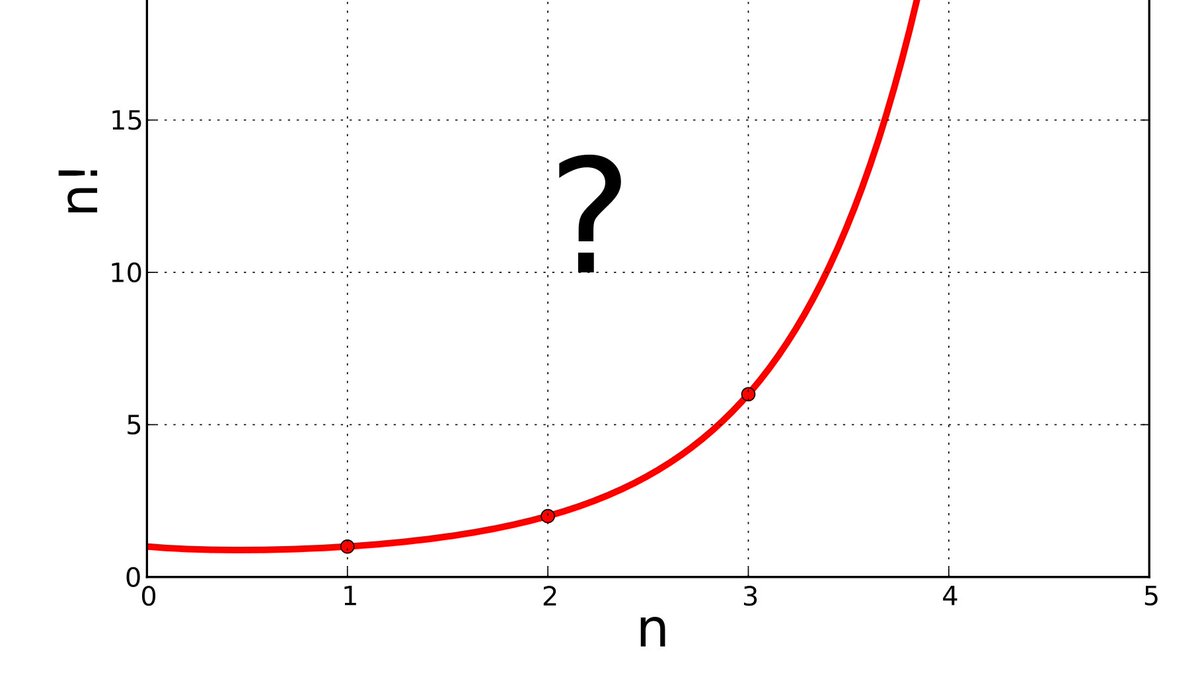This thread is based around reading this phenomenal summary of the Gamma function from a historic perspective + some other interesting tidbits I find
https://www.maa.org/sites/default/files/pdf/upload_library/22/Chauvenet/Davis.pdf">https://www.maa.org/sites/def...
https://www.maa.org/sites/default/files/pdf/upload_library/22/Chauvenet/Davis.pdf">https://www.maa.org/sites/def...
So what is the Gamma function?
The intuitive way to think about it is as an extension of the factorial (n!).
The intuitive way to think about it is as an extension of the factorial (n!).
A factorial is just a handy way to represent the following product:
n! = 1*2*3*4....*n
Originally the symbol ("!") is defined only for nice whole integers but what happens if it& #39;s meaning is extended?
What is (1/2)! ?
n! = 1*2*3*4....*n
Originally the symbol ("!") is defined only for nice whole integers but what happens if it& #39;s meaning is extended?
What is (1/2)! ?
I love this beacuse it shows how assigning a symbol to something can lead to the arousal of new meaning.
This old meaning -> symbol -> new meaning (a superset of the old one) is truly a lens to view how math grows
This old meaning -> symbol -> new meaning (a superset of the old one) is truly a lens to view how math grows
Now back to our problem? What is the solution of (1/2)!?
It& #39;s easy to convince ourselves a solution like this should exist if we plot the factorials of some integers on a graph (taken from wikipedia)
It& #39;s easy to convince ourselves a solution like this should exist if we plot the factorials of some integers on a graph (taken from wikipedia)
This kind of problem is called an interpolation problem. I.e. trying to find what happens between discreet known points
What analytic expression is equal to the factorial for positive integers but also has meaning for other numbers
What analytic expression is equal to the factorial for positive integers but also has meaning for other numbers
The problem was initially raised when Daniel Bernoulli, James Stirling, and Christian Goldbach all famous mathematicians in their own right tried to tackle it at the beginning of the 18th century to no avail
It took till 1729 for no other than the infamous Leonhard Euler to solve this problem (in correspondence with the earlier mentioned Goldbach)
Going through Euler& #39;s solution (you can see the path he supposedly took in the paper) it& #39;s clear that he is willing to relax rigorousness to find a more elegant solution
Led by beauty
Led by beauty
The solution Euler finds is in the form of an integral and it& #39;s also called sometimes the second Euler integral (the first Euler integral is the Beta function, which is related to the Gamma function)
Let& #39;s play with our shiny new function.
It& #39;s easy to show that just like for a factorial:
n! = n*(n-1)!
For the Gamma function:
Gamma(x) = xGamma(x-1)
This leads to the interesting property of finding values for a fractional x. For example:
Gamma(1.5) = 1.5Gamma(0.5)
It& #39;s easy to show that just like for a factorial:
n! = n*(n-1)!
For the Gamma function:
Gamma(x) = xGamma(x-1)
This leads to the interesting property of finding values for a fractional x. For example:
Gamma(1.5) = 1.5Gamma(0.5)
Through some earlier manipulations and the Wallis product, we know that
Gamma(0.5) = sqrt(pi/2)
Meaning that:
Gamma(1.5) = 1.5*sqrt(pi/2)
And now we have an "easy" solution for positive fractional factorials
Gamma(0.5) = sqrt(pi/2)
Meaning that:
Gamma(1.5) = 1.5*sqrt(pi/2)
And now we have an "easy" solution for positive fractional factorials
The same can also be shown for negative fractions (though doing this for whole negative numbers will cause us more trouble)
Next, the article is going to dive into the extension of the Gamma function to complex numbers

 Read on Twitter
Read on Twitter


